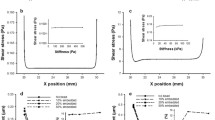Abstract
Strain concentrations associated with the presence of a microvascular network in a polymer matrix are measured using fluorescent digital image correlation (FDIC). The accuracy of the measurement technique is established for a specimen containing only a single microchannel. The influence of localized particle reinforcement around the channel is also investigated using this simplified geometry. Three-dimensional network specimens with different structural designs were fabricated and loaded in uniaxial tension. The resulting strain concentrations are compared as a function of channel spacing and location. As expected, decreasing channel spacing leads to increased strain local to the channels. In addition, the three-dimensional nature of the channel architecture influences the resulting strain. The results provide insight into the mechanical behavior of microvascular networks and demonstrate the utility of FDIC as a characterization tool at these length scales.











Similar content being viewed by others
References
Gotzen N (2003) Understanding stress concentration about a nutrient foramen. J Biomech 36:1511–1521
Nalla R, Kinney J, Ritchie R (2003) Mechanistic fracture criteria for the failure of human cortical bone. Nat Mater 2:164–168
Nalla R, Kruzic J, Ritchie R (2004) On the origin of the toughness of mineralized tissue: microcracking or crack bridging? Bone 34:790–798
Balooch G, Marshall G, Marshall S, Warren O, Asif S, Balooch M (2004) Evaluation of a new modulus mapping technique to investigate microstructural features of human teeth. J Biomech 37:1223–1232
Nalla R, Kinney J, Ritchie R (2003) Effect of orientation on the in vitro fracture toughness of dentin: the role of toughening mechanisms. Biomaterials 24:3955–3968
Therriault D, White S, Lewis J (2003) Chaotic mixing in three-dimensional microvascular networks fabricated by direct-write assembly. Nat Mater 2:265–271
Toohey K, Sottos N, Lewis J, Moore JS, White S (2007) Self-healing materials with microvascular networks. Nat Mater 6:581–585
Runyon M, Johnson-Kerner B, Ismagilov R (2004) Minimal functional model of hemostasis in a biomimetic microfluidic system. Angew Chem, Int Ed 43:1531–1536
Stroock A, Cabodi M (2006) Microfluidic biomaterials. MRS Bull 31:114–119
Lim D, Kamotani Y, Cho B, Mazumder J, Takayama S (2003) Fabrication of microfluidic mixers and artificial vasculatures using a high-brightness diode-pumped nd : Yag laser direct write method. Lab Chip 3:318–323
Toohey K, Sottos N, Lewis J, Moore JS, White S (2009) Characterization of microvascular-based self-healing coatings. Exp Mech 49(5):707–717
Williams HR, Trask RS, Bond IP (2007) Self-healing composite sandwich structures. Smart Mater. Struct. 16:1198–1207
Williams HR, Trask RS, Bond IP (2008) Self-healing sandwich panels: restoration of compressive strength after impact. Compos Sci Technol 68:3171–3177
White S, Sottos N, Geubelle P, Moore J (2001) Autonomic healing of polymer composites. Nature 409:794–797
Keller MW, White SR, Sottos NR (2007) A self-healing poly(dimethyl siloxane) elastomer. Adv. Funct. Mater. 17:2399–2404
Caruso MM, Blaiszik BJ, White SR, Sottos NR, Moore JS (2008) Full recovery of fracture toughness using a nontoxic solventbased selfhealing system. Adv. Funct. Mater. 18:1898–1904
Pang J, Bond I (2005) A hollow fibre reinforced polymer composite encompassing self-healing and enhanced damage visibility. Compos Sci Technol 65:1791–1799
Brown E, Sottos N, White S (2002) Fracture testing of a self-healing polymer composite. Exp Mech 42:74–83
Aragón A, Hansen C, Wu W, Geubelle P, Lewis J (2007) Computational design and optimization of a biomimetic self-healing/cooling composite material. Proc SPIE 6526
Kim S, Lorente S, Bejan A (2006) Vascularized materials: tree-shaped flow architectures matched canopy to canopy. J Appl Phys 100:063525
Williams HR, Trask RS, Knights AC, Williams ER, Bond IP (2008) Biomimetic reliability strategies for self-healing vascular networks in engineering materials. J R Soc Interface 5:735–747
Williams HR, Trask RS, Weaver P, Bond IP (2008) Minimum mass vascular networks in multifunctional materials. J R Soc Interface 5:55–65
Berfield T, Patel H, Shimmin R, Braun P, Lambros J, Sottos N (2006) Fluorescent image correlation for nanoscale deformation measurements. Small 2:631–635
Berfield TA, Patel JK, Shimmin RG, Braun PV, Lambros J, Sottos NR (2007) Micro- and nanoscale deformation measurement of surface and internal planes via digital image correlation. Exp Mech 47:51–62
Bruck H, McNeill S, Sutton M, Peters W (1989) Digital image correlation using newton-raphson method of partial-differential correction. Exp Mech 29:261–267
Peters WH, Ranson WF (1982) Digital imaging techniques in experimental stress-analysis. Opt Eng 21:427–431
Verhaegh N, Blaaderen A (1994) Dispersions of rhodamine-labeled silica spheres: synthesis, characterization, and fluorescence confocal scanning microscopy. Langmuir 10:1427–1438
Bornert M, Bremand F, Doumalin P, Dupre JC, Fazzini M, Grediac M, Hild F, Mistou S, Molimard J, Orteu JJ, Robert L, Surrel Y, Vacher P, Wattrisse B (2009) Assessment of digital image correlation measurement errors: methodology and results. Exp Mech 49:353–370
Besnard G, Hild F, Roux S (2006) “Finite-element” displacement fields analysis from digital images: application to Portevin–Le Châtelier bands. Exp Mech 46(6):789–803
Savin G (1970) Stress distribution around holes. NASA Technical Translation. Washington, D.C.
Savin G (1961) Stress concentration around holes. Pergamon Press, New York
Ahmed S, Jones F (1990) A review of particulate reinforcement theories for polymer composites. J Mater Sci 25:4933–4942
Acknowledgement
This work was supported by the Air Force Office of Scientific Research Multidisciplinary University Research Initiative (grant F49550-05-1-0346).
Author information
Authors and Affiliations
Corresponding author
Rights and permissions
About this article
Cite this article
Hamilton, A.R., Sottos, N.R. & White, S.R. Local Strain Concentrations in a Microvascular Network. Exp Mech 50, 255–263 (2010). https://doi.org/10.1007/s11340-009-9299-5
Received:
Accepted:
Published:
Issue Date:
DOI: https://doi.org/10.1007/s11340-009-9299-5




